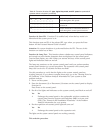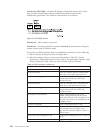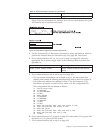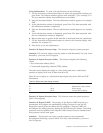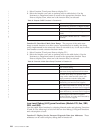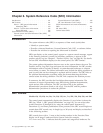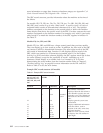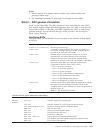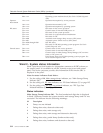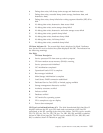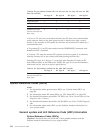See “Low-level debug and data collecting procedures” on page 131 for more
information.
Function 58–Setting First Character of the Base Address for the Function 62
Display: See “Low-level debug and data collecting procedures” on page 131 for
more information.
Function 59–Setting Second Character of the Base Address for the Function 62
Display: See “Low-level debug and data collecting procedures” on page 131 for
more information.
Function 60–Setting Third Character of Address for Function 62 Display: See
“Low-level debug and data collecting procedures” on page 131 for more
information.
Function 61–Setting Fourth Character of Address for Function 62 Display: See
“Low-level debug and data collecting procedures” on page 131 for more
information.
Function 62–Display Service Processor Storage: This function displays service
processor storage starting at the address that has been set with functions 58
through 61. See “Low-level debug and data collecting procedures” on page 131 for
more information.
Function 63–System Status SRC Trace: The system status SRC trace is a copy of
the last 25 status SRCs (those that are usually associated with the IPL sequence or
the power-off sequence).
Enter a subfunction between hexadecimal 00 and 18 to look at the status SRCs in
sequential order. The most recent SRC (the last status SRC) appears at subfunction
hexadecimal 18.
See “Low-level debug and data collecting procedures” on page 131 for more
information.
Function 64–Diagnostic Status SRC Trace: The diagnostic status SRC trace is a
copy of the last 25 status SRCs (those that are usually associated with the service
processor function of problem analysis and main store dump).
Enter a subfunction between hexadecimal 00 and 18 to look at the status SRCs in
sequence. You can see the most recent SRC (the last status SRC) at subfunction
hexadecimal 18 and the extended SRC words for this SRC at subfunctions 19
through 1A.
See “Low-level debug and data collecting procedures” on page 131 for more
information.
Function 65–Deactivate Remote Service: Function 65 is available only when you
have previously selected Manual mode and extended panel functions 25 and 26.
Use this function to deactivate a remote service session or iSeries Operations
Console. This function releases the communications port that was in use for a
remote service session or iSeries Operations Console.
Function 66–Activate Remote Service: Function 66 is available only when you
have previously selected Manual mode and extended panel functions 25 and 26.
Chapter 5. Control Panel Functions 189



